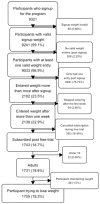Evaluation of Intermittent Restricted Eating Using the Interval Weight Loss Online Platform in an Everyday Setting
- PMID: 39861462
- PMCID: PMC11768033
- DOI: 10.3390/nu17020332
Evaluation of Intermittent Restricted Eating Using the Interval Weight Loss Online Platform in an Everyday Setting
Abstract
Background/Objectives: Obesity remains a global health challenge. Many commercial online weight loss programs are available, and they have advantages in terms of scalability and access. Few of these programs have been evaluated for effectiveness in a real-world context. This study reports on the weight loss achieved, platform engagement, and characteristics of successful weight loss predictions in subscribers to the Interval Weight Loss (IWL) program. The Interval Weight Loss program promotes intermittent restricted eating in addition to lifestyle changes in diet composition, exercise, and sleep. Methods: Data for 1705 adults subscribing to the program for >30 days between 2019 and 2024 were included in the analysis. A linear mixed model with polynomial terms was used to model weight loss over time with interaction terms for gender and age. Survival analysis was used to model the proportions and time frame of those meeting 2%, 5%, and 10% weight loss targets and the proportion meeting their goal weight. The focus of the analysis was on the effect at 365 days. Descriptive data from a subset of participants (n = 205) who completed a questionnaire about change in lifestyle habits and mood are also presented. Results: Of those who stayed in the program for at least 365 days, 25.4% achieved their goal weight, 17.6% achieved a 10% weight loss, and 62% achieved a 5% weight loss. By 49 days, 50% had lost 2% of their weight. Significant interactions indicated that males and females in their 60s and 70s were the most responsive to the program. Conclusions: The online commercial Interval Weight Loss platform based on intermittent restricted eating resulted in significant weight loss in a cohort of subscribers in a real-world setting.
Keywords: commercial weight loss program; intermittent restricted eating; online weight loss.
Conflict of interest statement
The IWL program had no role in the design of this study; or the interpretation of data; or in the writing of the manuscript other than to verify the description of the program was correct; or in the decision to publish the results.
Figures





Similar articles
-
Weight Loss and Usage of an Online Commercial Weight Loss Program (the CSIRO Total Wellbeing Diet Online) Delivered in an Everyday Context: Five-Year Evaluation in a Community Cohort.J Med Internet Res. 2021 Jun 7;23(6):e20981. doi: 10.2196/20981. J Med Internet Res. 2021. PMID: 34096869 Free PMC article.
-
The change in eating behaviors in a Web-based weight loss program: a longitudinal analysis of study completers.J Med Internet Res. 2014 Nov 3;16(11):e234. doi: 10.2196/jmir.3131. J Med Internet Res. 2014. PMID: 25367316 Free PMC article.
-
Online platform for healthy weight loss in adults with overweight and obesity - the "POEmaS" project: a randomized controlled trial.BMC Public Health. 2018 Aug 1;18(1):945. doi: 10.1186/s12889-018-5882-y. BMC Public Health. 2018. PMID: 30068393 Free PMC article.
-
Web-Based Digital Health Interventions for Weight Loss and Lifestyle Habit Changes in Overweight and Obese Adults: Systematic Review and Meta-Analysis.J Med Internet Res. 2019 Jan 8;21(1):e298. doi: 10.2196/jmir.9609. J Med Internet Res. 2019. PMID: 30622090 Free PMC article.
-
A review and critique of published real-world weight management program studies.Postgrad Med. 2018 Aug;130(6):548-560. doi: 10.1080/00325481.2018.1498280. Epub 2018 Aug 11. Postgrad Med. 2018. PMID: 29987943 Review.
References
-
- NCD Risk Factor Collaboration (NCD-RisC) Worldwide trends in underweight and obesity from 1990 to 2022: A pooled analysis of 3663 population-representative studies with 222 million children, adolescents, and adults. Lancet. 2024;403:1027–1050. doi: 10.1016/S0140-6736(23)02750-2. - DOI - PMC - PubMed
-
- Beleigoli A.M., Andrade A.Q., Cancado A.G., Paulo M.N., Diniz M.F.H., Ribeiro A.L. Web-Based Digital Health Interventions for Weight Loss and Lifestyle Habit Changes in Overweight and Obese Adults: Systematic Review and Meta-Analysis. J. Med. Internet Res. 2019;21:e298. doi: 10.2196/jmir.9609. - DOI - PMC - PubMed
-
- Kupila S.K.E., Joki A., Suojanen L.U., Pietilainen K.H. The Effectiveness of eHealth Interventions for Weight Loss and Weight Loss Maintenance in Adults with Overweight or Obesity: A Systematic Review of Systematic Reviews. Curr. Obes. Rep. 2023;12:371–394. doi: 10.1007/s13679-023-00515-2. - DOI - PMC - PubMed
-
- Gonzales K. Book Weight Loss Services in Australia—Market Research Report 2014–2029 ANZSIC 2006 9512. IBISWorld; Melbourne, Australia: 2024.
MeSH terms
LinkOut - more resources
Full Text Sources
Medical

